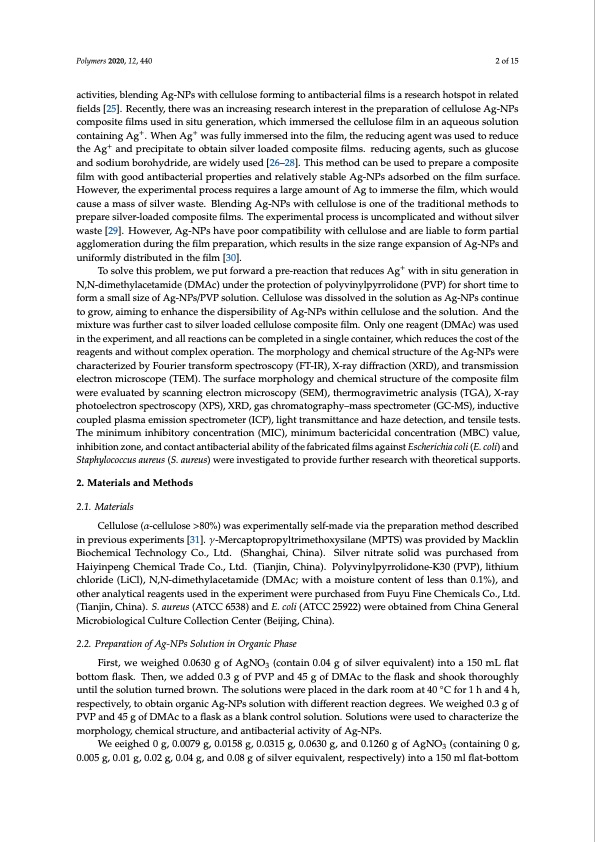
PDF Publication Title:
Text from PDF Page: 002
Polymers 2020, 12, 440 2 of 15 activities, blending Ag-NPs with cellulose forming to antibacterial films is a research hotspot in related fields [25]. Recently, there was an increasing research interest in the preparation of cellulose Ag-NPs composite films used in situ generation, which immersed the cellulose film in an aqueous solution containing Ag+. When Ag+ was fully immersed into the film, the reducing agent was used to reduce the Ag+ and precipitate to obtain silver loaded composite films. reducing agents, such as glucose and sodium borohydride, are widely used [26–28]. This method can be used to prepare a composite film with good antibacterial properties and relatively stable Ag-NPs adsorbed on the film surface. However, the experimental process requires a large amount of Ag to immerse the film, which would cause a mass of silver waste. Blending Ag-NPs with cellulose is one of the traditional methods to prepare silver-loaded composite films. The experimental process is uncomplicated and without silver waste [29]. However, Ag-NPs have poor compatibility with cellulose and are liable to form partial agglomeration during the film preparation, which results in the size range expansion of Ag-NPs and uniformly distributed in the film [30]. To solve this problem, we put forward a pre-reaction that reduces Ag+ with in situ generation in N,N-dimethylacetamide (DMAc) under the protection of polyvinylpyrrolidone (PVP) for short time to form a small size of Ag-NPs/PVP solution. Cellulose was dissolved in the solution as Ag-NPs continue to grow, aiming to enhance the dispersibility of Ag-NPs within cellulose and the solution. And the mixture was further cast to silver loaded cellulose composite film. Only one reagent (DMAc) was used in the experiment, and all reactions can be completed in a single container, which reduces the cost of the reagents and without complex operation. The morphology and chemical structure of the Ag-NPs were characterized by Fourier transform spectroscopy (FT-IR), X-ray diffraction (XRD), and transmission electron microscope (TEM). The surface morphology and chemical structure of the composite film were evaluated by scanning electron microscopy (SEM), thermogravimetric analysis (TGA), X-ray photoelectron spectroscopy (XPS), XRD, gas chromatography–mass spectrometer (GC-MS), inductive coupled plasma emission spectrometer (ICP), light transmittance and haze detection, and tensile tests. The minimum inhibitory concentration (MIC), minimum bactericidal concentration (MBC) value, inhibition zone, and contact antibacterial ability of the fabricated films against Escherichia coli (E. coli) and Staphylococcus aureus (S. aureus) were investigated to provide further research with theoretical supports. 2. Materials and Methods 2.1. Materials Cellulose (α-cellulose >80%) was experimentally self-made via the preparation method described in previous experiments [31]. γ-Mercaptopropyltrimethoxysilane (MPTS) was provided by Macklin Biochemical Technology Co., Ltd. (Shanghai, China). Silver nitrate solid was purchased from Haiyinpeng Chemical Trade Co., Ltd. (Tianjin, China). Polyvinylpyrrolidone-K30 (PVP), lithium chloride (LiCl), N,N-dimethylacetamide (DMAc; with a moisture content of less than 0.1%), and other analytical reagents used in the experiment were purchased from Fuyu Fine Chemicals Co., Ltd. (Tianjin, China). S. aureus (ATCC 6538) and E. coli (ATCC 25922) were obtained from China General Microbiological Culture Collection Center (Beijing, China). 2.2. Preparation of Ag-NPs Solution in Organic Phase First, we weighed 0.0630 g of AgNO3 (contain 0.04 g of silver equivalent) into a 150 mL flat bottom flask. Then, we added 0.3 g of PVP and 45 g of DMAc to the flask and shook thoroughly until the solution turned brown. The solutions were placed in the dark room at 40 ◦C for 1 h and 4 h, respectively, to obtain organic Ag-NPs solution with different reaction degrees. We weighed 0.3 g of PVP and 45 g of DMAc to a flask as a blank control solution. Solutions were used to characterize the morphology, chemical structure, and antibacterial activity of Ag-NPs. We eeighed 0 g, 0.0079 g, 0.0158 g, 0.0315 g, 0.0630 g, and 0.1260 g of AgNO3 (containing 0 g, 0.005 g, 0.01 g, 0.02 g, 0.04 g, and 0.08 g of silver equivalent, respectively) into a 150 ml flat-bottomPDF Image | One-Pot Synthesis of Antibacterial Silver Nanoparticle

PDF Search Title:
One-Pot Synthesis of Antibacterial Silver NanoparticleOriginal File Name Searched:
polymers-12-00440-v2.pdfDIY PDF Search: Google It | Yahoo | Bing
Turbine and System Plans CAD CAM: Special for this month, any plans are $10,000 for complete Cad/Cam blueprints. License is for one build. Try before you buy a production license. More Info
Waste Heat Power Technology: Organic Rankine Cycle uses waste heat to make electricity, shaft horsepower and cooling. More Info
All Turbine and System Products: Infinity Turbine ORD systems, turbine generator sets, build plans and more to use your waste heat from 30C to 100C. More Info
CO2 Phase Change Demonstrator: CO2 goes supercritical at 30 C. This is a experimental platform which you can use to demonstrate phase change with low heat. Includes integration area for small CO2 turbine, static generator, and more. This can also be used for a GTL Gas to Liquids experimental platform. More Info
Introducing the Infinity Turbine Products Infinity Turbine develops and builds systems for making power from waste heat. It also is working on innovative strategies for storing, making, and deploying energy. More Info
Need Strategy? Use our Consulting and analyst services Infinity Turbine LLC is pleased to announce its consulting and analyst services. We have worked in the renewable energy industry as a researcher, developing sales and markets, along with may inventions and innovations. More Info
Made in USA with Global Energy Millennial Web Engine These pages were made with the Global Energy Web PDF Engine using Filemaker (Claris) software.
Infinity Turbine Developing Spinning Disc Reactor SDR or Spinning Disc Reactors reduce processing time for liquid production of Silver Nanoparticles.
| CONTACT TEL: 608-238-6001 Email: greg@infinityturbine.com | RSS | AMP |